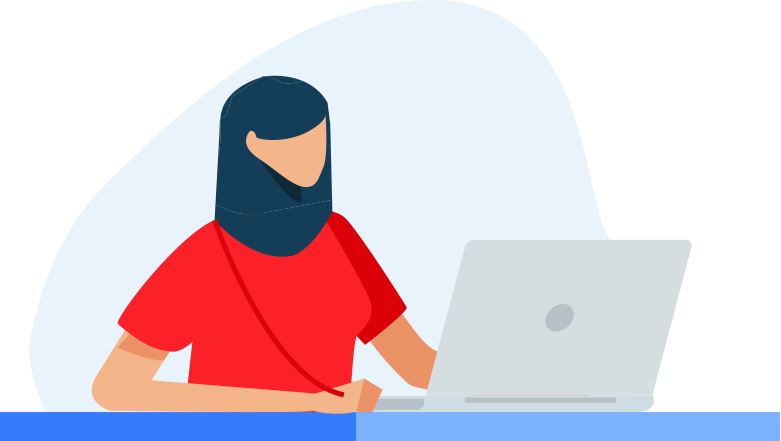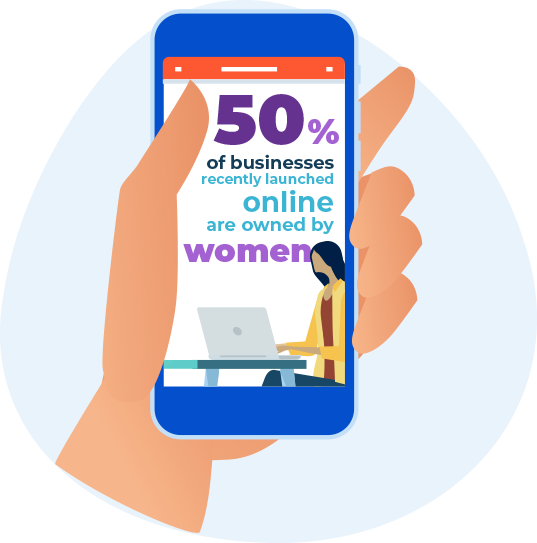×
Warning
Joomla\CMS\Cache\Storage\FileStorage::_deleteFolder JFolder: :delete: Could not delete folder. Path: [ROOT]/cache/plg_flexisystem_handleFileTranfers
5.5 Women Entrepreneurship and Innovation
2 MIN READ
It’s no great surprise that innovation is often associated with technology. In the world of entrepreneurship, businesses that are seen as “innovative” often operate in the fields of science, technology, engineering and mathematics (STEM) — fields that are traditionally men-dominated.1 To understand what entrepreneurial innovation is, let’s first take a look at what the Organisation for Economic Co-operation and Development (OECD) says about business innovation:“An innovation is a new or improved product or process (or combination thereof) that differs significantly from the unit’s previous product or processes and that has been made available to potential users (product) or brought into use by the unit (process).”2
This broad definition of innovation involves much more than using cutting-edge technology and creating or offering new products. There are many ways entrepreneurs can innovate and here are a few examples:

- New marketing strategies
- Improvements to production processes or worksites
- New organizational practices
- Building new networks and partnerships
Are women entrepreneurs innovative?
When it comes to innovation trends, there is no significant difference between women-owned and men-owned businesses.3
Percentages of small and medium enterprises (SMEs) in Canada that innovate:4
- Women-owned: 30.1%
- Men-owned: 31.2%
Women entrepreneurs are just as innovative as men. Unfortunately, loans and grants typically given to innovative businesses often target companies operating in the STEM fields.5 Many companies that innovate differently, including women-owned businesses, may find themselves without significant financing opportunities. Also, innovation can be shaped by factors such as access to financing, networks, business contacts and the availability to work overtime — factors which may pose barriers to innovation for some women entrepreneurs.6

Women entrepreneurs and digital technology
According to a survey conducted by Startup Canada, 93% of women stated that digital technology is a key factor for them when starting a business.7 Just like men, women entrepreneurs have business websites; they also use online data analysis and cloud computing.8
Did you know?
- According to studies, 50% of businesses recently launched online in Canada are owned by women.9
- Women-owned businesses are slightly more likely to have websites than all other SMEs (55.5% for women, compared to 53.2% for all other SMEs).10
- Women-owned businesses are more likely to offer online payment options than men-owned businesses (11.7% as opposed to 8.0%).11
Women are connected entrepreneurs with a significant online presence — in fact, studies show that women are more active online than men,12 which could prove to be useful as they are more likely to use social media to keep in touch with clients and networks. In today’s world, using digital technology in that way can help women to achieve business success and long-term viability. Furthermore, having an online business and using e-commerce often provides a more neutral platform, eliminating barriers such as gender bias and distribution network access.13 It is a perfect time to "refresh” the pages of the traditional business textbooks and connect more with women entrepreneurs.
Our toolkit includes data taken from the 2017 Survey on financing and growth of small and medium enterprises. The 2022 Survey is available at the following link: https://www150.statcan.gc.ca/n1/daily-quotidien/220302/dq220302b-cansim-eng.htm
However, please note that the data included in this most recent survey is greatly influenced by the recent worldwide pandemic, making it difficult to compare it to the stats included in our toolkit which are based on a pre-pandemic period survey.
Download & Print Tool
References
1The Beacon Agency (March 2018) Everywhere, Every Day Innovating: Women Entrepreneurs and Innovation Report, with Carleton University, BMO Financial Group, Innovation, Science, and Economic Development Canada and Indigenous and Northern Affaires Canada, p. 8.; Women Entrepreneurship Knowledge Hub (2020). The State of Women’s Entrepreneurship in Canada 2020, Toronto, Diversity Institute, Toronto Metropolitan University, p. 27.
2OECD/Eurostat (2018). Oslo Manual 2018: Guidelines for Collecting, Reporting and Using Data on Innovation, 4th Edition, The Measurement of Scientific, Technological and Innovation Activities, OECD Publishing, Paris/Eurostat, Luxembourg. https://doi.org/10.1787/24132764-en, p. 20.
3ISED (2018). Survey on financing and growth of small and medium enterprises (SFGSME), 2017, Innovation, Science, and Economic Development Canada, Government of Canada, https://www.ic.gc.ca/eic/site/061.nsf/vwapj/SFGSME-EFCPME_2017_eng_public.pdf/$file/SFGSME-EFCPME_2017_eng_public.pdf (page consulted October 23rd 2020).
4ISED (2018). Survey on financing and growth of small and medium enterprises (SFGSME), 2017, Innovation, Science, and Economic Development Canada, Government of Canada, https://www.ic.gc.ca/eic/site/061.nsf/vwapj/SFGSME-EFCPME_2017_eng_public.pdf/$file/SFGSME-EFCPME_2017_eng_public.pdf (page consulted October 23rd 2020).
5The Beacon Agency (March 2018) Everywhere, Every Day Innovating: Women Entrepreneurs and Innovation Report, with Carleton University, BMO Financial Group, Innovation, Science, and Economic Development Canada and Indigenous and Northern Affaires Canada, p. 8, 10.
6The Beacon Agency (March 2018) Everywhere, Every Day Innovating: Women Entrepreneurs and Innovation Report, with Carleton University, BMO Financial Group, Innovation, Science, and Economic Development Canada and Indigenous and Northern Affaires Canada, p. 19.
7The Beacon Agency (March 2018) Everywhere, Every Day Innovating: Women Entrepreneurs and Innovation Report, with Carleton University, BMO Financial Group, Innovation, Science, and Economic Development Canada and Indigenous and Northern Affaires Canada, p. 19.; Startup Canada. (2017). Advancing Digital Adoption Amongst Women SBOs in Canada, p. 14.
8Huju Liu (April 2019). Research Blog: Women-owned businesses in Canada, Statistics Canada, https://www.statcan.gc.ca/eng/blog/cs/wob (page consulted November 2nd 2020).
9Paypal Canada and Barraza & Associates (August 2018). Women Entrepreneurship Study, p. 3.; Women Entrepreneurship Knowledge Hub. Explore Data, Diversity Institute, Toronto Metropolitan University, https://wekh.ca/data/ (page consulted September 8th 2020).
10Audrey Ann Bélanger Baur (October 2019). Women-owned Exporting Small and Medium Enterprises, Descriptive and comparative analysis, Global Affairs Canada, Government of Canada, https://www.international.gc.ca/trade-commerce/assets/pdfs/economist-economiste/analysis-analyse/women_owned-export-entreprises_femmes-eng.pdf, p. 7.
11Audrey Ann Bélanger Baur (October 2019). Women-owned Exporting Small and Medium Enterprises, Descriptive and comparative analysis, Global Affairs Canada, Government of Canada, https://www.international.gc.ca/trade-commerce/assets/pdfs/economist-economiste/analysis-analyse/women_owned-export-entreprises_femmes-eng.pdf, p. 7.
12Audrey Ann Bélanger Baur (October 2019). Women-owned Exporting Small and Medium Enterprises, Descriptive and comparative analysis, Global Affairs Canada, Government of Canada, https://www.international.gc.ca/trade-commerce/assets/pdfs/economist-economiste/analysis-analyse/women_owned-export-entreprises_femmes-eng.pdf, p. 7.
13Audrey Ann Bélanger Baur (October 2019). Women-owned Exporting Small and Medium Enterprises, Descriptive and comparative analysis, Global Affairs Canada, Government of Canada, https://www.international.gc.ca/trade-commerce/assets/pdfs/economist-economiste/analysis-analyse/women_owned-export-entreprises_femmes-eng.pdf, p. 7.
2OECD/Eurostat (2018). Oslo Manual 2018: Guidelines for Collecting, Reporting and Using Data on Innovation, 4th Edition, The Measurement of Scientific, Technological and Innovation Activities, OECD Publishing, Paris/Eurostat, Luxembourg. https://doi.org/10.1787/24132764-en, p. 20.
3ISED (2018). Survey on financing and growth of small and medium enterprises (SFGSME), 2017, Innovation, Science, and Economic Development Canada, Government of Canada, https://www.ic.gc.ca/eic/site/061.nsf/vwapj/SFGSME-EFCPME_2017_eng_public.pdf/$file/SFGSME-EFCPME_2017_eng_public.pdf (page consulted October 23rd 2020).
4ISED (2018). Survey on financing and growth of small and medium enterprises (SFGSME), 2017, Innovation, Science, and Economic Development Canada, Government of Canada, https://www.ic.gc.ca/eic/site/061.nsf/vwapj/SFGSME-EFCPME_2017_eng_public.pdf/$file/SFGSME-EFCPME_2017_eng_public.pdf (page consulted October 23rd 2020).
5The Beacon Agency (March 2018) Everywhere, Every Day Innovating: Women Entrepreneurs and Innovation Report, with Carleton University, BMO Financial Group, Innovation, Science, and Economic Development Canada and Indigenous and Northern Affaires Canada, p. 8, 10.
6The Beacon Agency (March 2018) Everywhere, Every Day Innovating: Women Entrepreneurs and Innovation Report, with Carleton University, BMO Financial Group, Innovation, Science, and Economic Development Canada and Indigenous and Northern Affaires Canada, p. 19.
7The Beacon Agency (March 2018) Everywhere, Every Day Innovating: Women Entrepreneurs and Innovation Report, with Carleton University, BMO Financial Group, Innovation, Science, and Economic Development Canada and Indigenous and Northern Affaires Canada, p. 19.; Startup Canada. (2017). Advancing Digital Adoption Amongst Women SBOs in Canada, p. 14.
8Huju Liu (April 2019). Research Blog: Women-owned businesses in Canada, Statistics Canada, https://www.statcan.gc.ca/eng/blog/cs/wob (page consulted November 2nd 2020).
9Paypal Canada and Barraza & Associates (August 2018). Women Entrepreneurship Study, p. 3.; Women Entrepreneurship Knowledge Hub. Explore Data, Diversity Institute, Toronto Metropolitan University, https://wekh.ca/data/ (page consulted September 8th 2020).
10Audrey Ann Bélanger Baur (October 2019). Women-owned Exporting Small and Medium Enterprises, Descriptive and comparative analysis, Global Affairs Canada, Government of Canada, https://www.international.gc.ca/trade-commerce/assets/pdfs/economist-economiste/analysis-analyse/women_owned-export-entreprises_femmes-eng.pdf, p. 7.
11Audrey Ann Bélanger Baur (October 2019). Women-owned Exporting Small and Medium Enterprises, Descriptive and comparative analysis, Global Affairs Canada, Government of Canada, https://www.international.gc.ca/trade-commerce/assets/pdfs/economist-economiste/analysis-analyse/women_owned-export-entreprises_femmes-eng.pdf, p. 7.
12Audrey Ann Bélanger Baur (October 2019). Women-owned Exporting Small and Medium Enterprises, Descriptive and comparative analysis, Global Affairs Canada, Government of Canada, https://www.international.gc.ca/trade-commerce/assets/pdfs/economist-economiste/analysis-analyse/women_owned-export-entreprises_femmes-eng.pdf, p. 7.
13Audrey Ann Bélanger Baur (October 2019). Women-owned Exporting Small and Medium Enterprises, Descriptive and comparative analysis, Global Affairs Canada, Government of Canada, https://www.international.gc.ca/trade-commerce/assets/pdfs/economist-economiste/analysis-analyse/women_owned-export-entreprises_femmes-eng.pdf, p. 7.
Disclaimer
All documents prepared for the LEADING LENDERS project were developed in line with the most appropriate and recent terminology. However, we recognize that terminology is subject to change over time. To the best of our ability, we have attempted to use terminology that respects the dignity and rights of all individuals.
All documents prepared for the LEADING LENDERS project were developed in line with the most appropriate and recent terminology. However, we recognize that terminology is subject to change over time. To the best of our ability, we have attempted to use terminology that respects the dignity and rights of all individuals.
Share:

